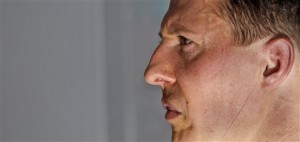Spotlight on artificial coma in Schumacher case
GRENOBLE, France – Formula One ace Michael Schumacher remains in intensive care nearly a month after a ski accident that left him plunged into a medically induced coma whose outcome remains unclear.
After his December 29 fall at Meribel ski resort in the French Alps, Schumacher was sedated and cooled to around 35 degrees Celsius (95 degrees Fahrenheit) to ease the risk of further damage to the brain.
Surgeons at Grenoble University Hospital say they decided on the coma after operating on bleeding and bruising in his brain.
They carried out a post-operative scan that revealed “widespread lesions” on both sides of the brain.
A second operation, to treat bleeding, took place on December 30.
There has been no update on his condition since January 17, when his spokesman Sabine Kehm, said he was still “stable” and that his family had complete trust in his treatment.
Independent experts, interviewed by AFP, refused to comment on Schumacher’s individual case but agreed to talk in general terms about treatment options in instances such as his.
“A blow to the head causes bruising, a swelling, which takes place in a confined space, the skull, which leads to pressure on the brain,” Gerard Audibert, a professor of neurosurgery at the University Hospital Centre in Nancy, eastern France.
“One way to control it is to ensure that the patient and the brain are at rest and to control his ventilation, using an artificial respirator to oxygenate his brain.”
“It’s quite rare” for a coma to be induced for more than three weeks, he said.
Artificial comas “can last a long time, days or weeks,” said Professor Jean Mantz, in charge of anaesthesia at the intensive care unit at Bichat-Beaujon-Louis Mourier Hospital in Paris.
Once pressure within the skull has stabilized at a normal level, sedation levels are scaled back and the patient returns to consciousness, but “it’s not unexceptional for a patient not to revive,” said Audibert.
“There are all sorts of ways of testing the patient for responses, but nothing replaces physical contact,” said Bernard Vigue of the University Hospital Centre at Bicetre, in the southern Paris suburbs.
“It starts with simple requests, such as ‘squeeze my hand.'”
In accidents of a similar severity, patients often had a disability after their emergence from coma, the sources noted.
“Recovery can be a very long road. In some case, patients improve between a year and three years later,” said Vigue.
Schumacher, who turned 45 on January 3, dominated Formula One.
He won the F1 title seven times, more than any other driver, and notched up 91 victories between 1994 and 2004.
He first retired aged 37 but was unable to resist the lure of the track. In 2010, he came out of retirement but was unable to recover his previous performance and quit for good in 2012.
As an F1 racer, Schumacher was known for his daring overtaking maneuvers, his at-times almost reckless abandon in the pursuit of victory and his mastery of tricky conditions presented by rain.
On that fateful day at the Meribel resort, Schumacher appears to have skied on a partially covered rock, lost his balance and fallen on another rock further down, according to the prosecutor in charge of the probe.
The impact was so strong it smashed his helmet in two.
Investigators have ruled out faulty skis, inadequate signage or excessive speed as possible causes.
